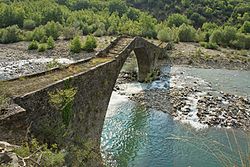Papastathis Bridge
Papastathis Bridge Γεφύρι του Παπαστάθη | |
|---|---|
 Bridge Papastathis | |
| Coordinates | 39°36′59.7″N 21°01′27.7″E / 39.616583°N 21.024361°E |
| Carries | Pedestrian (footbridge) |
| Crosses | Arachthos River |
| Locale | Ioannina, Greece |
| Owner | Hellenic Ministry of Culture and Sports |
| Characteristics | |
| Material | Stone |
| Width | 27 metres (89 ft) |
| Height | 870 m (2,854 ft 4 in) |
| No. of spans | 1 |
| Piers in water | 2 |
| History | |
| Construction end | 1746 |
| Location | |
 | |
The Papastathis Bridge (Greek: Γέφυρα του Παπαστάθη) is a four-arched bridge in Greece that is located between Driscos and Anatolike and crosses the Arachthos river, in the region of Epirus, near the town of Ioannina.[1]
Description
[edit]The bridge was built in 1746 by the Abbot of Viliza Monastery, Agapios, who spent 175 Venetian florins on it.[2] In order for the project to be completed, however, twice as many were needed, which were painstakingly collected by the villagers of the surrounding villages. The need to build the bridge was great because the Arachthos drowned 3 to 4 people every year in that passage. In 1942, the Germans bombed the great arch of the bridge during anti-partisan operations, but the bridge was left standing. Finally, according to local legend when the Arachthos overflows at night one can hear the crying voices of a man and a rooster who were built on the foundations of the bridge.[3][4][5][2]
See also
[edit]References
[edit]- ^ «Γεφύρι Παπαστάθη στον Άραχθο ποταμό Archived 2018-02-13 at the Wayback Machine» από Υπουργείο Πολιτισμού και Αθλητισμού Archived 2017-12-01 at the Wayback Machine. Αρχειοθετήθηκε 13 Φεβρ.2018. Ανακτήθηκε 13 Φεβρ.2018
- ^ a b «Γεφύρι του Παπαστάθη»από τον ιστότοπο «Πέτρινα Γεφύρια της Ηπείρου» του Πανεπιστημίου Ιωαννίνων. Καταγραφή 10 August .2006. Αρχειοθέτηση 20 Ιουνίου 2010. Access 13 February 2018
- ^ Νίτσα Συνίκη Παπακώστα, Πέτρινα γεφύρια, εκδ. Νομαρχιακής Αυτοδιοίκησης Ιωαννίνων, 2002, p. 74
- ^ Spyros Mantas, Το γεφύρι και ο Ηπειρώτης, publ. Λαϊκό Πολύπτυχο, Athens 1987, p. 198
- ^ Giorgos and Eve Belligianni, Πέτρινα τοξωτά γεφύρια της Ελλάδας, publ. Μίλητος, 2011, p. 69
External links
[edit]- «Papastathis Bridge». Archived 13 February 2018.
